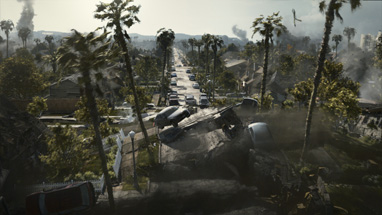Hollywood Psych: 2012
By Sean Collier
November 19, 2009
BoxOfficeProphets.com

Emmerich was frequently asked if he wrestled with this decision, and he claims that he did; ultimately, though, he felt that the resilience of New York and America after 9/11 would be echoed in his film. The fact that approximately 99% of New York and a good two-thirds of America were annihilated at his hands, of course, notwithstanding. In a further attempt to defend his intentions, he bizarrely pointed to the fact that he left the Statue of Liberty standing throughout the film as a sign of sensitivity.
In 2012, Emmerich has topped his previous, robust body counts; the catastrophic earth-heating (or whatever it was) purportedly kills all but 600,000 survivors, and maybe a couple million sub-Saharan Africans. Once again circumventing science and logic, the director has callously annihilated just about the whole planet, save the plucky survivors we've been hanging out with for the past three hours. 2012 isn't gory or even particularly violent – it is rated PG-13, after all – but the inescapable fact is that about six billion are killed in the course of the film.
When thinking of 9/11, Hurricane Katrina, recent devastating tsunamis, and other real-world tragedies, one might be inclined to ask audiences why they're so willing to watch fatal mayhem on the big screen, especially in the guise of mindless popcorn entertainment. We've seen this on CNN – how can we marvel at it in IMAX?
The crowds aren't to be blamed, however (except for a lack of general taste, but that's another column.) We confront our fears and our darkest experiences through cinema, and we have been trained to disassociate. Entire genres would vanish if we didn't have the ability to enjoy something that we would not revel in were it real. Even closer to 9/11, audiences were simply pushing the tragedy out of their heads when they bought a ticket to The Day After Tomorrow. It's natural.
No, the villain here is Emmerich. Not for cultural insensitivity, not for the locations he chooses, not for timing his films around actual tragedy, but simply for his callousness and apathy towards death. He is completely unwilling to deal with the consequences of his buildings toppling on the screen; even if our leads are standing next to a toppling skyscraper, a hurtling train, a collapsing bridge, we can never see human figures falling to their deaths; we merely see cars, windows, steel. When the (quite obviously) doomed characters among our title actors meet their end, it is usually offscreen, and they are always survived by characters that we liked a bit better anyway.
It's not surprising that Emmerich's characters, like the director himself – do not acknowledge the corpses piling up around them. We need them to continue to run straight ahead and duck death at every turn, fight to save themselves against preposterous odds and contrived plot devices, and generally keep things lively; if they stopped to consider that everyone they've ever loved is dead, they might get a bit blue.
In 2012, the only character that shows empathy for the sea of human volcano fodder is the seven-year-old girl; the implication, here, is that only children worry about such things. During the film's signature escape sequence, John Cusack swerves into some yards to pass a car driven by a set of elderly women; their sudden deaths a moment later are quite unabashedly played for laughs.
The shame in 2012 is not that a film about such a disaster was made, or that people paid to see it. The tragedy is that this work is in the hands of a man who demonstrates no understanding of death, no acknowledgement that the demise of human beings is worth remarking on, and no comprehension that keeping a million or so alive against a tally of billions dead is in no way a victory. Our disaster cinema is being made by a man with a callous disregard for death. This should disturb us more than it does.